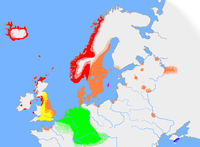Norsemen
Jump to navigationJump to search
| Part of a series on the |
| Norse people |
|---|

Extent of Norse language in 900 AD: Western Norse in red and Eastern Norse in orange.
|
| WikiProject Norse history and culture |
The Norsemen (or Norse people) were the North Germanic peoples of the Early Middle Ages, during which they spoke Old Norse language and practiced Old Norse religion.[1][2][3][4] The language belongs to the North Germanic branch of the Indo-European languages and is the predecessor of the modern Germanic languages of Scandinavia.[4] During the late eighth century, Norsemen embarked on a large-scale expansion in all directions, giving rise to the Viking Age. In English-language scholarship since the 19th century, Norse seafaring traders, settlers and warriors have commonly been referred to as Vikings. Though lacking a common ethnonym, the Viking Age Norsemen still had a common identity, which survives among their modern descendants,[5] the Danes, Icelanders,[a] Faroe Islanders,[a] Norwegians and Swedes,[6] who are now generally referred to as “Scandinavians” rather than Norsemen.[7]
History of the terms Norseman and Northman[edit]
The word Norseman first appears in English during the early 19th century: the earliest attestation given in the third edition of the
Recent Comments